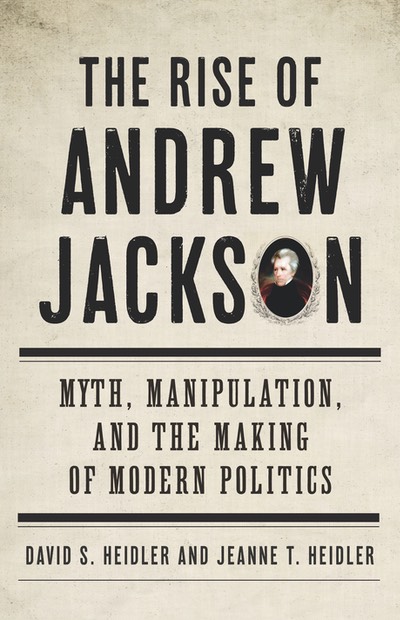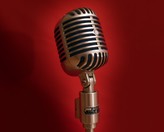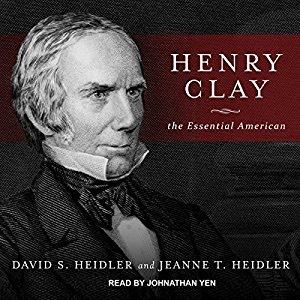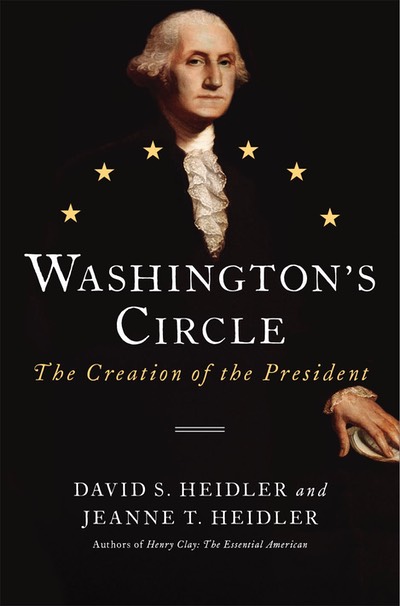Today, April 30, 1789, George Washington was sworn in as the nation’s first president. New York City fairly crackled with excitement over the event and actually did so that night with a fantastic fireworks display, already an American tradition for commemorating important occasions. Thomas Paine had written during the Revolution, “We have it in our power to begin the world over again.” That April day, Americans were intent on proving it. We describe the inauguration ceremony in Washington’s Circle: The Creation of the President, from which the following has been adapted.
On the morning of April 30 as church bells pealed, George Washington stood waiting at the entrance of a balcony that overlooked the intersection of Wall and Broad Streets. A multitude filled the streets and roofs around New York’s City Hall, lately called Federal Hall after an extensive remodeling. John Adams motioned for Washington to come through the doors. The bells fell silent, and he appeared before a hushed crowd. He slowly bowed. The sight of him at first was too imposing for outbursts, but the bow unleashed a great torrent of noise, a growing roar from a crowd that stamped and whistled in appreciation. They were not looking at a great man surveying his loyal subjects but a fellow citizen bowing before the majesty of the people. Chancellor Robert R. Livingston, the highest ranking judicial figure in New York, waited for the cheers to subside before administering the oath of office. Nobody minded waiting for the crowd to calm down. On that April day everyone was excited. Everything seemed possible.
Except possibly the ceremony itself. A momentary panic had seized Livingston as Washington was set to appear. It turned out that no one had brought a Bible. Invoking his authority as the Grand Master of the St. John’s Masonic Lodge, Livingston had its Bible rushed to Federal Hall. Samuel Otis now held it, for in his capacity as Secretary of the Senate, he would present it for Washington to touch as he took the oath of office. Of less than average height, Otis was dwarfed by the tall figures of Livingston and Washington, and when he placed the Bible on a red satin cushion, he seemed unsure about the best way to hold it for Washington’s comfort. Otis’s son, Harrison Gray Otis (Harry to friends and family) watched nervously from the crowd, but Washington placed his hand on the Bible with Otis slightly bowing and clinching the cushion. The crowd became eerily silent. Livingston spoke the oath, pausing for Washington to repeat its phrases, now familiar but entirely new in their first use on April 30, 1789.
A museum display at Mount Vernon recreates the inauguation with stunning realism
When Washington completed his pledge to faithfully execute his office and uphold the Constitution, some heard him proclaim “so help me God,” though that remembrance surfaced some years later. Everyone, however, saw Otis awkwardly raise the cushion toward Washington’s face. It seemed to surprise him. He motioned for Otis to lower it and then bowed to kiss it. Livingston was already turning toward the crowd, and his shouting voice broke the silence: “Long Live George Washington, President of the United States!” but he had only gotten half the words out when the crowd raised a wall of noise across Wall Street so loud that the men on the balcony could not hear themselves speak. A flag went up atop Federal Hall, the signal for an artillery salute that seemed to startle everyone into silence. Washington bowed to the crowd, and that set it off again as he turned slowly and walked back to the Senate chamber to deliver his inaugural address.
It was only 464 words long and took fewer than fifteen minutes to deliver. Its brevity was matched by a lack of urbanity in its delivery, which was becoming. A young Massachusetts congressman named Fisher Ames described the feelings of many. He was more deeply moved by the man than his words. “Time has made havoc upon his face,” Ames noted. Something about Washington touched him, “his aspect grave, almost to sadness.” The deep voice had sometimes paused incongruously, as was Washington’s way, but it had also quavered. It was odd for a large man obviously accustomed to being in command. Everyone’s eyes had trailed down from the time-scarred face to the papers in his hands, finally fixing on the hands themselves. Throughout the quarter hour of this first inaugural address, George Washington’s hands were trembling.
That night, he attended a reception at Livingston’s home and another at Henry Knox’s where everyone watched rockets light the sky. Wealthy New Yorkers competed to display the most elaborate transparency, that popular though pricey method for festively illuminating pictures. Many depicted scenes from the country’s brief past and featured giant images of Washington. French Minister Elénor-François-Elie, Comte de Moustier, scored a triumph with a huge display that illustrated not only the history of the United States but also showed scenes prophesying the future greatness of the nation. Cynics might have smirked. The country was broke, enemies prowled its borders, and the world was inclined to believe that Moustier’s optimistic vision of American prospects was more wishful than prophetic.
Yet standing at the center of a swirling pool of expectation and anxiety was the tall figure with the impeccable posture, his head tilted back, his face impassive as his eyes tracked the sparkling arcs of rockets. The odds were long, but that April night in America, anything was possible, even a solvent treasury and peaceful border, even friendly commerce with a world that was spinning its way toward an American dawn. The transparencies told a story, but the rockets rushing upward were more than an ornament. They were an emblem. George Washington and his friends watched them.



